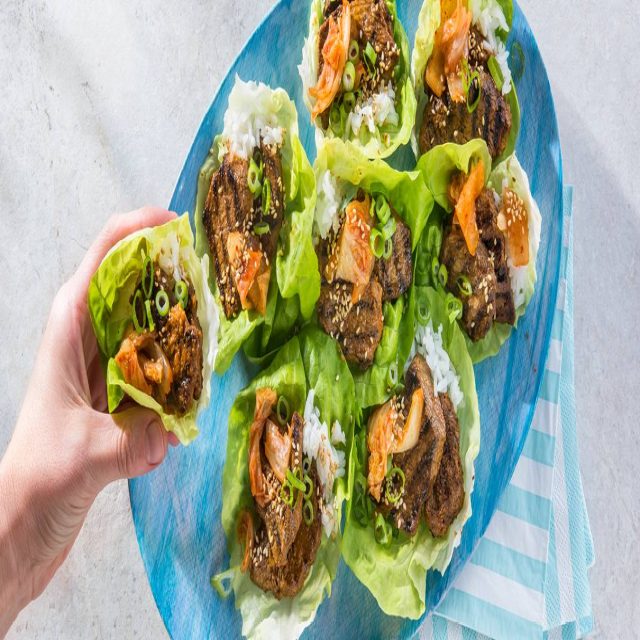Korea
When it comes to food in South Korea, the sides are as important as the main course. Meals are traditionally served with an assortment of banchan’s, small plates that are something in between condiment and side dish. Among the best-known banchan is kimchi, fermented cabbage made with a chili paste called gochujang. This bright red paste adds sweet heat and authentic flavor to a wide range of Korean recipes, including our crunchy take on the popular national dish, bulgogi. Literally translated as “fire meat,” this grilled beef gets its complex flavor from a gochujang-infused marinade with soy sauce, sesame oil, and the sweetness of fresh pear. Add a side of tangy kimchi (available in the refrigerated produce section), and savor the experience of a classic Korean dinner.

There are eight different food regions in the vast nation of China, each with its own distinctive identity the dishes of Shanghai stand out as a star. Along with abundant fresh seafood, like whole roasted fish and crab, street food is a large part of the food culture in Shanghai. Among the most iconic of these budget-friendly bites served from carts and stalls, around the city is a comforting plate of stir-fried Shanghai-style noodles. Our simple version is made with fried green onions, fresh ginger, and baby Bok choy for an added dose of nutrients and crunch.

When you think of Japanese cuisine, you probably think of sushi or ramen. But did you know that the island nation is also famous for its distinctive style of chicken? Yakitori, or “grilled bird” is a popular dish sold from street carts and in specialized shops called yakitori-ya. While the dish itself is simple – seasoned chicken grilled and served on skewers – the variations are numerous. Depending on the region and the shop, yakitori might include chicken breast, wings, gizzards, intestines, or crispy skin. Our tasty version uses boneless, skinless chicken thighs flavored with ginger, scallions, and mirin, a traditional Japanese rice cooking wine.

The cuisine of India is complex and regional, but one basic distinction is North vs. South. In the South, dishes are typically vegetarian, with lentils, vegetables, and rice serving as the go-to ingredients. Food from the North includes meat and is closer to what you’re likely to find in American Indian restaurants, including naan, samosas, and curries. One popular Northern Indian dish that is savored around the world is tandoori. Referring to both a style of preparation and the clay oven used to make it, tandoori involves cooking meat, seafood, bread, and other dishes over very high heat for deep, lightly charred flavor and crisp texture. We took tandoori inspiration to the backyard barbecue for these quick and easy shrimp skewers made with a traditional curry-spiked yogurt marinade.

Fresh fruit, seafood, and bold spices are the hallmarks of food in Thailand. The lush climate is home to a range of produce, including signature aromatic ingredients like lemongrass, fiery bird’s eye chilis, makrut limes (also known askaffir limes), and coconut. Flavorful curries made with meat, fish, or vegetables cooked in coconut milk and served over rice are a popular meal throughout the country. We captured the tropical flavors of mango and fresh herbs in this refreshing, summery salad made with crunchy cucumber and umami-rich fish sauce, another traditional Thai ingredient.

Vietnamese cuisine is celebrated for its bold combinations of fresh, flavorful ingredients. Bright green herbs, like cilantro, mint, and basil, are used abundantly, along with warm aromatics like cinnamon, star anise, and ginger. Street food carts, popular throughout Vietnam, are the source of some of the country’s most widely known dishes, including pho soup and bahn mi sandwiches. In the hot climate of Vietnam, another popular bite is light, refreshing summer rolls. Our version uses pre-cooked shrimp along with a rainbow of crunchy veggies and herbs wrapped inside rice paper for a beautiful, no-cook appetizer that’s ready in 15 minutes.

The unique food culture of Hawaii reflects both its Polynesian heritage and many international influences, including American, Japanese, and Chinese. Fresh tuna is a staple in Hawaii, where it’s often served raw as poke, along with local fresh fruits like pineapple, passion fruit, and lychee. Poi, a starchy paste made from fermented taro root, is a staple of the Hawaiian diet and part of the traditional menu served at luaus. The real food star of these beachfront celebrations, however, is a whole Kalua pig roasted in an underground oven. Our version recreates the rich taste and juicy, fork-tender texture using just five ingredients and the Instant Pot ®.

Cuisine from the more than 7,000 islands that make up the Philippines includes a rich combination of seafood and meat, like pork, beef, and oxtail. Fish curries, cured beef, and oxtail-peanut stew are all popular Filipino dishes. Spanish food influences can also be found in the Philippines, including local versions of paella, torta (Spanish-style omelets), and lechon (Spanish-style roasted pig). No food is more synonymous with the Philippines, however, than the official national dish, adobo. Though the ingredients vary by region – some make it with chicken, others with pork or fish – every type of adobo includes a combination of vinegar and spices for savory, sweet-sour flavor. Our ultra-moist, flavorful version made with chicken thighs comes together in the slow cooker with just 10 minutes of prep.












